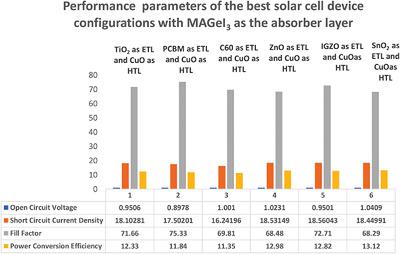当前位置:
X-MOL 学术
›
Adv. Theory Simul.
›
论文详情
Our official English website, www.x-mol.net, welcomes your feedback! (Note: you will need to create a separate account there.)
Comparative Study on the Performance of Different Lead‐Based and Lead‐Free Perovskite Solar Cells
Advanced Theory and Simulations ( IF 3.3 ) Pub Date : 2021-03-25 , DOI: 10.1002/adts.202100027 Deepthi Jayan K. 1, 2 , Varkey Sebastian 1
Advanced Theory and Simulations ( IF 3.3 ) Pub Date : 2021-03-25 , DOI: 10.1002/adts.202100027 Deepthi Jayan K. 1, 2 , Varkey Sebastian 1
Affiliation

|
A comparative theoretical study on the performance of perovskite solar cells (PSCs) with methyl ammonium lead iodide (MAPbI3) and methyl ammonium germanium iodide (MAGeI3) as absorber layers is reported by modeling the solar cells for a number of electron transport materials (ETMs), hole transport materials, and back‐contact metals using solar cell capacitance simulator 1D tool. For MAPbI3 as the absorber layer, the best photovoltaic performance is observed for the configuration glass/fluorine‐doped tin oxide (FTO)/SnO2/MAPbI3/NiO/Au with a power conversion efficiency (PCE) of 20.58% and a fill factor (FF) of 68.34% and for MAGeI3, the configuration glass/FTO/SnO2/MAGeI3/CuO/Pd exhibits the best performance with a PCE of 13.12% and a FF of 68.29%. This study indicates that the low‐cost metal oxide SnO2 is a better substitute for the commonly used TiO2 as ETM, and the metal oxides like NiO and CuO provide a higher PCE for device configurations with MAPbI3 and MAGeI3, respectively, as the absorber layer. The low‐cost back‐contact metal Pd provides a better performance for MAGeI3‐based PSCs. This study also indicates that the nontoxic MAGeI3‐based PSCs can be used for commercial applications as they are more thermally stable than the MAPbI3‐based PSCs and provide an equally good quantum efficiency curve as that of MAPbI3‐based PSCs.
中文翻译:

不同铅基和无铅钙钛矿太阳能电池性能的比较研究
通过对许多电子传输材料的太阳能电池进行建模,报道了对以甲基铵碘化铅(MAPbI 3)和甲基碘化锗铵(MAGeI 3)作为吸收层的钙钛矿型太阳能电池(PSC)性能的比较理论研究。ETM),空穴传输材料和背面接触金属,使用太阳能电池电容模拟器1D工具。对于MAPbI 3作为吸收层,对于配置玻璃/掺氟氧化锡(FTO)/ SnO 2 / MAPbI 3 / NiO / Au的配置,观察到最佳的光伏性能,功率转换效率(PCE)为20.58%,填充因子(FF)为68.34%,对于MAGeI 3,配置玻璃/ FTO / SnO 2/ MAGeI 3 / CuO / Pd表现出最佳性能,PCE为13.12%,FF为68.29%。这项研究表明,低成本的金属氧化物的SnO 2是用于常用的TiO一个更好的替代品2为ETM和类似的NiO和CuO的金属氧化物提供与MAPbI设备配置更高的PCE 3和MAGeI 3分别作为吸收层。低成本的背接触金属Pd为基于MAGeI 3的PSC提供了更好的性能。这项研究还表明,基于无毒MAGeI 3的PSC比MAPbI 3具有更高的热稳定性,因此可用于商业应用的PSC,并提供与基于MAPbI 3的PSC相同的量子效率曲线。
更新日期:2021-05-05
中文翻译:

不同铅基和无铅钙钛矿太阳能电池性能的比较研究
通过对许多电子传输材料的太阳能电池进行建模,报道了对以甲基铵碘化铅(MAPbI 3)和甲基碘化锗铵(MAGeI 3)作为吸收层的钙钛矿型太阳能电池(PSC)性能的比较理论研究。ETM),空穴传输材料和背面接触金属,使用太阳能电池电容模拟器1D工具。对于MAPbI 3作为吸收层,对于配置玻璃/掺氟氧化锡(FTO)/ SnO 2 / MAPbI 3 / NiO / Au的配置,观察到最佳的光伏性能,功率转换效率(PCE)为20.58%,填充因子(FF)为68.34%,对于MAGeI 3,配置玻璃/ FTO / SnO 2/ MAGeI 3 / CuO / Pd表现出最佳性能,PCE为13.12%,FF为68.29%。这项研究表明,低成本的金属氧化物的SnO 2是用于常用的TiO一个更好的替代品2为ETM和类似的NiO和CuO的金属氧化物提供与MAPbI设备配置更高的PCE 3和MAGeI 3分别作为吸收层。低成本的背接触金属Pd为基于MAGeI 3的PSC提供了更好的性能。这项研究还表明,基于无毒MAGeI 3的PSC比MAPbI 3具有更高的热稳定性,因此可用于商业应用的PSC,并提供与基于MAPbI 3的PSC相同的量子效率曲线。



























 京公网安备 11010802027423号
京公网安备 11010802027423号